Northern Ireland’s bank branches are disappearing, but who is left behind?

Scott Kennerley, Director of Financial Services at the Consumer Council for Northern Ireland explains the impact of bank branch closures in the region.
As Northern Ireland’s statutory consumer body, working to promote and protect the interests of consumers, the Consumer Council carries out a breadth of work in the financial services sector including consumer empowerment, education and research programmes to influence public policy.
Between May 2020 and January 2023, banks in Northern Ireland permanently closed 52 branches, meaning that in less than three years Northern Ireland had lost 27 per cent of its total bank branch network.
The Consumer Council conducted research in 2022 to quantify the impact of bank branch closures on consumers here.
Northern Ireland has a different banking market compared to the rest of the UK. We have different service providers, a lower level of access to cash, a greater reliance on physical cash, high levels of financial vulnerability, large rural communities, and greater dependency on benefit income.
Our research highlights the disproportionate impact that bank branch closures have on some consumers, particularly the most vulnerable, and the need for more tailored solutions.
Who is impacted most: Vulnerable consumers and those in rural areas
According to the Financial Conduct Authority, 21 per cent of adults in the UK regularly use a physical bank branch, this figure increases to 29 per cent in Northern Ireland. Those most likely to regularly use a branch in the 12 months to May 2022 included digitally excluded consumers (42 per cent), those who were heavy users of cash (42 per cent), those with a household income of less than £15,000 a year (37 per cent), those aged 75+ (35 per cent), and those in poor health (27 per cent) – particularly those who were blind or partially sighted (37 per cent).
Our research shows that bank branch closures have had a disproportionate negative impact on consumers with a disability, those on low incomes, older consumers, and those living in rural areas who are also more reliant on accessible banking services.
Over a third of Northern Ireland’s most disadvantaged consumers, who are those living in deprived areas with lower levels of employment, health, and access to services, live more than 1km away from a banking service. In addition, only 46 per cent of individuals with a disability and 44 per cent of people aged over 65 live within 1km of a banking service.
Almost a quarter of electoral wards in Northern Ireland do not have a bank branch. Over a third of people (36 per cent) in Northern Ireland live in rural areas. Of those in rural areas where their local bank closed, half of them said that it had a major impact on them and their local community.
The majority of businesses in Northern Ireland are small to micro, and challenges experienced by rural businesses are often the same as rural individuals.
Limitations of alternative options
The alternatives provided for consumers when a branch closes such as using the Post Office, mobile, or telephone banking, do not meet everyone’s needs.
Our research shows that consumers regularly use the Post Office for basic banking needs and find it a convenient solution. However, consumers also told us they had concerns around confidentiality when banking in a Post Office and the expertise of staff to help with complex banking queries. The sustainability of banking services at Post Offices is another concern; it is subject to a commercial agreement between the banks and the Post Office which is periodically reviewed meaning banking services could end if banks and the Post Office cannot reach agreement in the future.
When things go wrong, or people are unsure, they often want to talk to someone face to face. The current alternatives do not meet the more complex banking needs consumers have when they need advice and support. Therefore, the sector needs to step up and meet those consumer needs with a variety of solutions.
Online and mobile banking can be prohibitive for some consumers, particularly around the cost of appropriate equipment to access these services, the digital literacy required to use them, and perceived security concerns. More must be done to enable these consumers to use online services, including greater consumer protection against scams and education around online safety.
Commercial decisions to close bank branches must be transparent with equal priority given to assessing the impact on local communities versus changing banking behaviours.
The need for more inclusive solutions
This research highlights the impact of bank branch closures particularly for vulnerable and rural consumers in Northern Ireland, calling to attention the need for tailored solutions.
The Consumer Council wants to see the banking industry come together to meet the changing needs of its customers and find inclusive solutions that best meet the needs of all consumers.
Work has commenced on developing banking hubs, in which customers of participating banks can visit a hub to carry out their banking needs. However, to date, only one banking hub has been announced for Northern Ireland (in Kilkeel) and it is yet to open.
“29 per cent of adults in Northern Ireland regularly use a physical bank branch, (compared to 21 per cent for the UK).”
Supporting consumers to become more confident using online banking solutions is one step and there are a range of projects that aim to help consumers become more confident using online services, as well as banking clinics operating at community venues at agreed times. Some of these solutions are already being developed or delivered and they require collaboration across the sector.
We know that bank branches are unlikely to return to high streets, but consumers should not be expected to change their banking behaviour without the appropriate consumer support and education needed to ensure that they can still access the banking services they need.

Consumers can contact the Consumer Council:
T: 028 9025 1600
E: contact@consumercouncil.org.uk
W: www.consumercouncil.org.uk





